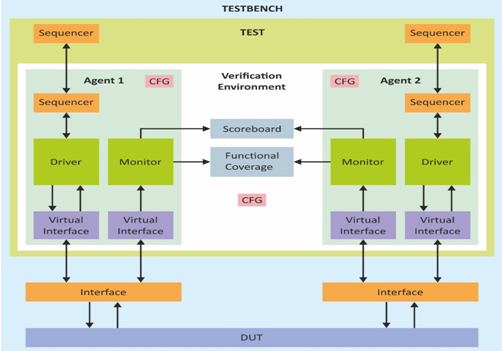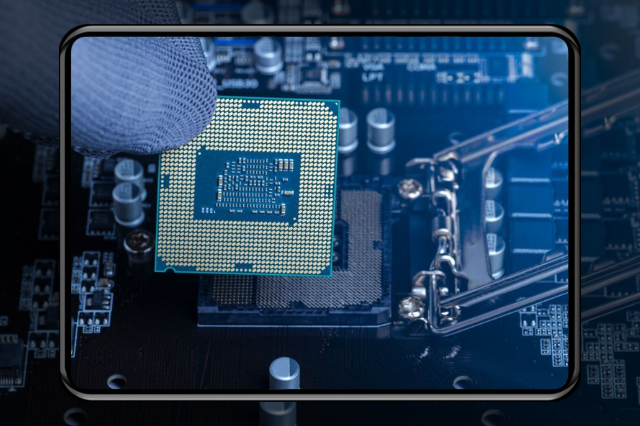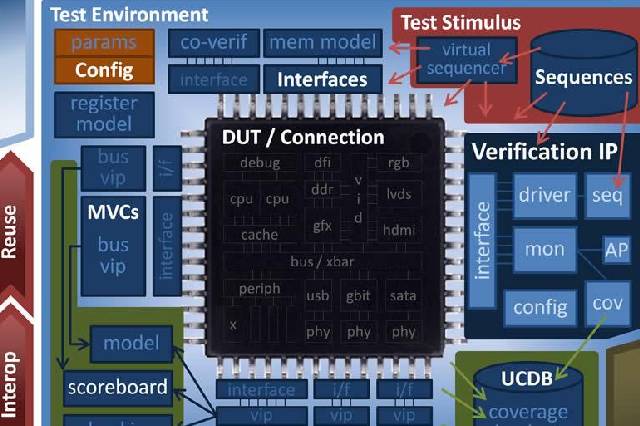
loading...

UVM – Universal Verification Methodology is a verification methodology that uses the system Verilog to have a robust and reusable verification environment. It was established by Accellera and jointly developed by Cadence and Synopsys. It is mainly derived from the OVM(open verification methodology). On May 17, 2010, UVM 1.0 was made available.Its Class Library offers the building blocks required to swiftly create well-designed and reusable verification components and test environments.System Verilog is used as the language for it. UVM is now supported by all three of the major simulation providers (Synopsys, Cadence, and Mentor), which was not achievable with earlier verification methodologies such as OVM, VMM and eRM.
Universal Verification Methodology is an open-sourcemethodology,It is primarily intended for verification IP and testbench components, enabling more portable and universal test benches and verification codes.Each verification component adheres to a uniform architecture and a full set of elements for simulating, testing, and gathering functional coverage.The verification environment generated using UVM remains the same regardless of the vendor, while the verification environment developed using System-Verilog may vary depending on the implementer.
As the industry is growing and technologies are evolving day by day, complex designs are the real challenge for any verification engineer to verify its functionality. It’s a verification engineer’s responsibility to make sure the design is bug-free before it’s tape out. Verification is the most time-consuming process in a chip’s manufacturing cycle right from day one. Missing a bug in the initial stage and capturing it in its final stage will cause a lot of issues financially as re-spin is a very expensive process to do.

Figure1: UVM Testbench Architecture
System Verilog would help engineers to verify super complex designs with a lot of flexibility with object-oriented support. Along with OOPs it also has some verification-targeted features like functional coverage, Assertions, Random constraints, etc. These features make the language very powerful and handy to use and have the potential to reduce verification time and effort.
UVM with the help of system Verilog would make the testbench environment more streamlined and reusable. A general UVM testbench architecture is illustrated in fig 1.
Features of UVM:
Comparison of System Verilog and UVM:
Benefits of Universal Verification Methodology:
|
Sr. No. |
Key Benefit |
Description |
|
1. |
Modularity and Reusability |
UVM is consisting ofmodular components such as a driver, sequencer, agents, and environment, this makes it possible to reuse components across the IP level to SoC/Subsystem/Chip, either horizontally (at the same level of abstraction) or vertically (from IP to SoC/Chip). |
|
2. |
Sequence methodology |
UVM offers good stimulus generation control.Sequences can be created in a variety of ways, including by randomization, layered sequences, virtual sequences, etc.This offers a good capability for controlled random stimulus generation. |
|
3. |
Configuration mechanism |
UVM makes complex object hierarchy configuration simpler.The configuration approach makes it simple to set up various testbench components depending on the verification environment that is being used, without having to worry about how deep a component is buried in the testbench hierarchy. |
|
3. |
Configuration mechanism |
UVM makes complex object hierarchy configuration simpler.The configuration approach makes it simple to set up various testbench components depending on the verification environment that is being used, without having to worry about how deep a component is buried in the testbench hierarchy. |
|
4. |
Separating Tests from Testbenches |
Tests in terms of stimuli and sequences are kept apart from the testbench hierarchy, allowing for the reuse of stimulus between projects. |
Conclusion
Compared to UVM, System Verilog hasfewer macro and function capabilities and no built-in reflection.Although some SystemVerilog capabilities may have been supplied as library functions.UVM combined with the system Verilog makes the verification work easier. The UVM testbench Architecture is the most followed verification architecture in the semiconductor industry. Building a reliable and reusable verification environment is not simple. A suitable framework and assistance from the base classes are required to develop it.UVM offers a comprehensive collection of the basic class libraries and features needed for effective verification. It provides a strong, simple-to-understand environment that may be used by other companies.While the industry kept on evolving the standard system Verilog and UVM created a benchmark in the semiconductor industry with their unique and powerful features.UVM offers a higher level of abstraction, therefore it takes less time to construct a testbench using it. The functional coverage is increased by virtually completely covering all scenarios and edge cases.
 Verilog Essentials: Mastering the Fundamentals of Hardware Description Language
Verilog Essentials: Mastering the Fundamentals of Hardware Description Language
 Unleashing the Power of System Verilog: A Comprehensive Guide for Aspiring Designers
Unleashing the Power of System Verilog: A Comprehensive Guide for Aspiring Designers
 Demystifying VLSI ch Design: Exploring the Core Concepts of VLSI Courses
Demystifying VLSI ch Design: Exploring the Core Concepts of VLSI Courses
 Basics of VLSI - An Ultimate Guide
Basics of VLSI - An Ultimate Guide
 Career Prospects After Completing A VLSI Course
Career Prospects After Completing A VLSI Course
 Top 5 Reasons To Take Up A Professional VLSI Course
Top 5 Reasons To Take Up A Professional VLSI Course
 Mastering VLSI Design: A Comprehensive Guide To Understanding Complex Integrated Circuits
Mastering VLSI Design: A Comprehensive Guide To Understanding Complex Integrated Circuits
 Future-Proof Your Career With A VLSI Course: How Learning About Integrated Circuits Can Boost Your Job Prospects?
Future-Proof Your Career With A VLSI Course: How Learning About Integrated Circuits Can Boost Your Job Prospects?
 System Verilog: An Overview
System Verilog: An Overview
 Introduction to Hardware Description Language (HDL)
Introduction to Hardware Description Language (HDL)
 Unlock The Potential Of VLSI Design With An Integrated VLSI Course Online
Unlock The Potential Of VLSI Design With An Integrated VLSI Course Online
 Universal Verification Methodology:An Efficient Verification Approach
Universal Verification Methodology:An Efficient Verification Approach
 How to Write a Verilog Module for Design and Testbench
How to Write a Verilog Module for Design and Testbench
 What Are the Different Career Paths in the VLSI Industry?
What Are the Different Career Paths in the VLSI Industry?
 Skills required to establish a successful career in VLSI
Skills required to establish a successful career in VLSI Looking for online VLSI courses? Futurewiz can fulfill your upskilling needs!
Looking for online VLSI courses? Futurewiz can fulfill your upskilling needs! The Future Of VLSI- Get All The Latest Insights!
The Future Of VLSI- Get All The Latest Insights! Super 50 Program For Advanced VLSI Design Training
Super 50 Program For Advanced VLSI Design Training Steps to Build Career in VLSI
Steps to Build Career in VLSI Similarities between C and Verilog
Similarities between C and Verilog What is UVM - A High-level overview
What is UVM - A High-level overview



